Matthew Savage played a pivotal role in reinventing the look of Doctor Who for the 21st Century. He was one of the first concept artists to work on the relaunched series and he developed the look of the TARDIS, the Daleks, the Cybermen and many new, weird and wonderful creations. Matthew worked as a concept artist on the 2005 and 2006 series. Since leaving the show he has become one of the most sought-after concept artists in movies, working on X-Men: First Class, Kick-Ass, The Dark Knight, Prometheus, Star Wars and many more. We were delighted when Matthew agreed to take time out of his busy schedule to recall his time on Doctor Who.
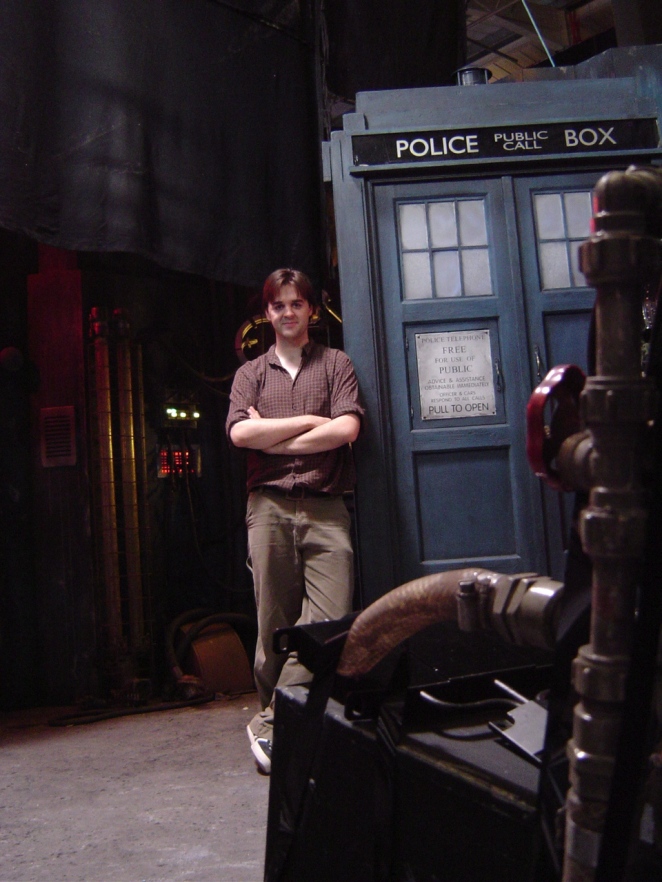
Matthew Savage on the set of The Girl in the Fireplace
WhoSFX: Was Doctor Who your first professional job?
Matthew: I had made tea and coffee on two movies prior to that within the art department but not actually designing. Doctor Who was my first proper concept artist job.
WhoSFX: Being a fan, that must have been pretty mind-blowing?
Matthew: I was so excited. I was ecstatic that the show was coming back, but to be involved in Season One was the ultimate experience you could have really. I was so happy from day one on the job. I couldn’t believe I was there.
WhoSFX: How did the job come about?
Matthew: I had sent BBC Wales a few portfolios and made a few phone calls but I hadn’t heard much back. I phoned BBC Wales one day and got through to the art department. Purely by chance, Dan Walker, who I had met on Batman Begins where I had been making tea and coffee, picked up the phone and said, “I think you’ve got a job.” I couldn’t believe it. He’d already started and he had either recommended me or put my portfolio under the nose of Edward Thomas. That was the Eureka moment. I couldn’t believe I actually got through to the office and that someone I knew picked up the phone. It was amazing.
WhoSFX: And were you thrown straight in at the deep-end?
Matthew: The first thing Ed gave me, literally after sitting me down and giving me a computer, he said to me “We’re going to get you started on the Daleks”. Ed had no idea I was a big fan and I tried my best to play it cool. At that point there were going to be two different types of Daleks in Series One. There was going to be a traditional-looking one in Dalek, and then for the two-part final there would be a new redesign. My colleague Dan Walker was working on the redesign, and they gave me the more traditional Dalek to work on. The redesign didn’t happen. It was going to be a 3D CGI thing from The Mill and they just ran out of time and money so they stuck with the bronze Daleks in the end.
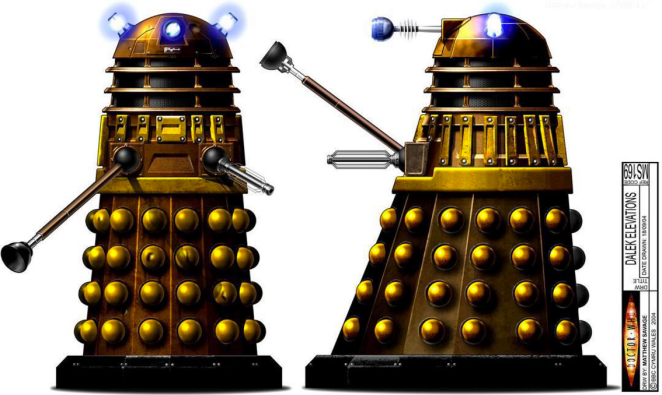
Matthew’s ‘Dalek Elevations’ concept art showing the new eyestalk, the new bronze colour and illustrating what would need to light up.
WhoSFX: Were you happy with how the design was brought to life?
Matthew: It’s easily the thing I am most proud of. I can’t believe they’re still using them ten years on. It’s a credit to the original design by Raymond Cusick. The original silhouette, it’s so strong. All it took was a few different textures and proportional changes. It’s still a perfect design.
WhoSFX: Were you briefed to stay pretty close to the original design?
Matthew: The brief for the design, and that episode in general, was ‘credibility’. In the years since the original Daleks, they’d become a bit of a joke. They were lumped in with the whole ‘wobbly set’ reputation thatDoctor Who had. We had to make them credible and give them menace. Russell T Davies gave me a Dalek toy from Genesis of the Daleks and said ‘this is the basic design. Keep the silhouette and just make it meaner. Bring out the metals and give it credibility.’
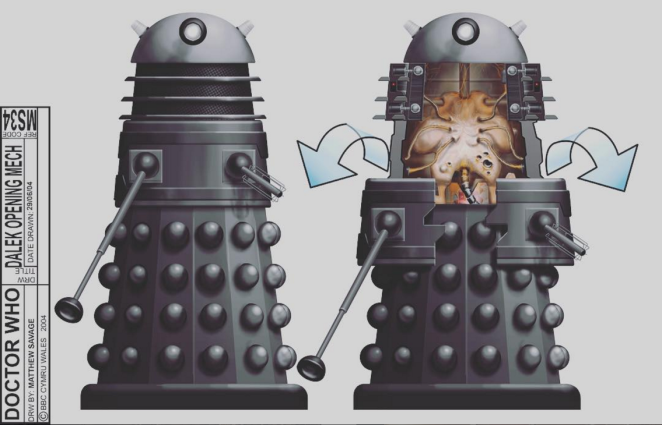
Concept art by Matthew Savage showing the Dalek opening up with elements folding down to reveal the mutant inside.
WhoSFX: Was RTD heavily involved with the art department?
Matthew: We would see Russell at least once a week or once a fortnight in the early days. I don’t now if he had his flat in Cardiff back then, but his involvement started ramping up as we began shooting. As soon as Ed was happy with a design and confident that we could practically achieve it, he would get me to e-mail it off to Russell. As show-runner Russell would oversee anything of that scale. And he would sketch as well. I may even have one of his original sketches of Cassandra that he did early on. I have files of old sketches in the loft and I’ve been meaning to dig them out for you. There may be some stuff that slipped through the net up there.
WhoSFX: Don’t tease me like that! I thought Cassandra was a classic character. Were you involved with her development?
Matthew: Cassandra may have been the second thing I did. Normally creature stuff would go to Millennium FX and I think they provided an on-set skin for Cassandra. But we definitely designed that in the art department; the frame and the brain. The End of the World was our first chance to prove that we could do grand scale sci-fi at BBC Wales, compared to the grounded nature of Rose as an opening episode. Rose was possibly everything I didn’t want to see as a Doctor Who fan, and then I watched it and realised it’s actually everything that it had to be to make it work today.
WhoSFX: Since the show came back, I think many people assume that it has a huge budget compared to the old days. That’s not the case is it?
Matthew: The budget was definitely not as big as people thought. The mentality of having to do more with less is always present in any kind of filmmaking, but more so with Doctor Who. The scope and ambition is so big but it’s still a TV budget. The ideas are feature film ideas. That’s the biggest problem Ed had on Doctor Who. The time and money available was so small. It was big for TV but small compared to anything else.
WhoSFX: Were you involved in the tone meetings?
Matthew: Not from the start. Ed was a mentor to me on and he introduced me to the tone meetings gradually throughout Season One. And then on Series Two and Torchwood I was more involved with the tone meetings and the divvying up of various elements to the relevant departments.
WhoSFX: Did you work closely with the likes of The Mill and Millennium FX or was it a case of handing over the concept art and moving on the next thing?
Matthew: It depends on the size of the thing we were working on. With something like the first Dalek, which Mike Tucker and his team built, we would produce some designs, get Russell involved and Mike would be involved all the way through. Something like that was a very heavy collaboration. For example, Mike might come back with ideas on what we could use for the eye, which would inform the design. There was always a massive cross-pollination depending on what you were working on. Everyone has limitations placed on them by time and money so you do your best to help them. Ed was always keen to give other departments a helping hand.
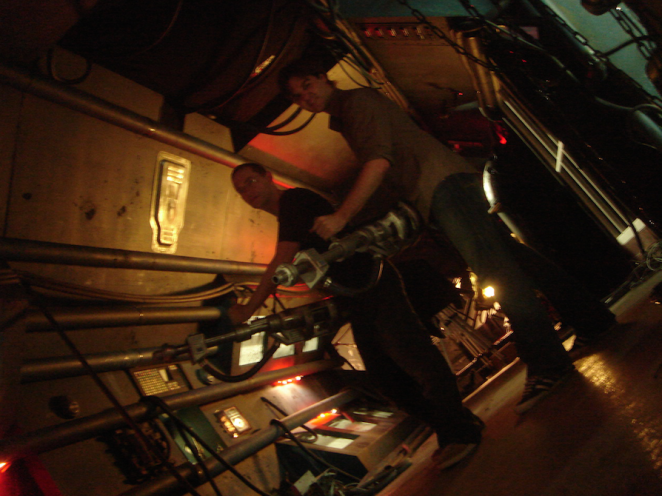
Matthew and fellow concept artist Peter McKinstry on the set of The Girl in the Fireplace
WhoSFX: Did you get to go on set quite a lot in the early days?
Matthew: On Season One we were based at Llandaff studios so we had to drive to Q2 in Newport, but for Series Two we moved down to the studio and we were literally on top of the set. If the sets were being constructed or the crew was on lunch, you could pop down and have a wander through the set. It was the only opportunity to see the sets in all their glory. The sets only exist for a few days before they are struck, taken down and recycled into another spaceship. It’s a massive shame but it’s all down to storage. These sets are so big. It might be different now with the Doctor Who Experience where they can keep some stuff.
WhoSFX: Was it difficult spending all that time crafting something only for it to be dismantled and thrown away?
Matthew: No. Filmmaking in general is so quick. The pay-off is that it is immortalised in some way on film or on TV. You can’t be precious about these things. I’ve worked on props for weeks and weeks that get no screen-time whatsoever. And then you do something really quickly, and it gets a massive close-up even though it’s rather shoddy and not something you’re massively proud of. You have to do the best you can and see what comes out at the other end. It’s worse for Mike Tucker; he ends up blowing his babies to smithereens. He spends months building something beautiful and then he has to stick a pyro underneath it!
WhoSFX: What was your involvement with the redesign of the TARDIS?
Matthew: I was involved. Ed and Dan were quite far down the line with the geometry of the room. I was more involved with detailing things like the roundels and the console. Again, I couldn’t believe what I was working on. On day one I saw the artwork that Dan had produced for the console room and it was such a magical feeling. I felt like a 12 year old again.
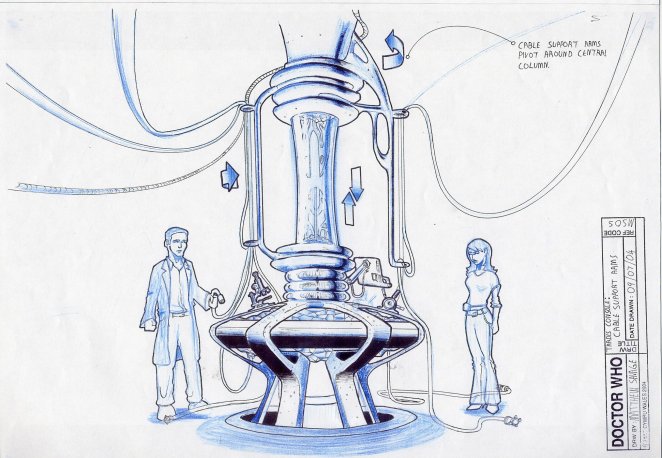
Pencil drawing by Matthew for the redesigned TARDIS console.
WhoSFX: There are some lovely pencil sketches that you did for the TARDIS console room. Did you like to work the old-fashioned way?
Matthew: I don’t think you can beat beginning the design process on paper. It’s more tactile and has a certain quality to it. Film and TV is so heavily computer-based today, that’s just the way you have to work but I always like to take a sketchbook to any job I’m doing. Doctor Who was my first (and probably my last) job working quite so heavily with pen and paper. I did pencil sketches of the TARDIS and marker sketches of the Daleks. I really miss working that way but it’s just so much quicker to do it in Photoshop now.
WhoSFX: Do you wish you’d had the tools that are available to you now?
Matthew: I think that all the time! I think that on most jobs; if only I could go back. I use lots of 3D software, things like ZBrush and Modo-Photoshop and I would kill to go back and do that job again with the software and the techniques I use now. I think I could do it quicker and better. That may not actually be true because the work back then did have a quality to it because it was old school and analog.
WhoSFX: Do you remember much about The Christmas Invasion?
Matthew: I remember prepping it in the summer. Ed famously brought back a shell after his holiday in Mauritius which he gave to me on my first day back and told me to design the Sycorax ship based on that. If I’m being honest, the Santa robots are not my proudest moment. I think Pete (McKinstry) nailed them the following year when they came back. I think they are a bit too two-dimensional. From memory, the brief was to make them like a kind of 50’s painted tin toy. It was a slightly turbulent time in terms of Christopher Eccleston leaving. It was a bit scary to come back so strong and then face a change so quickly.
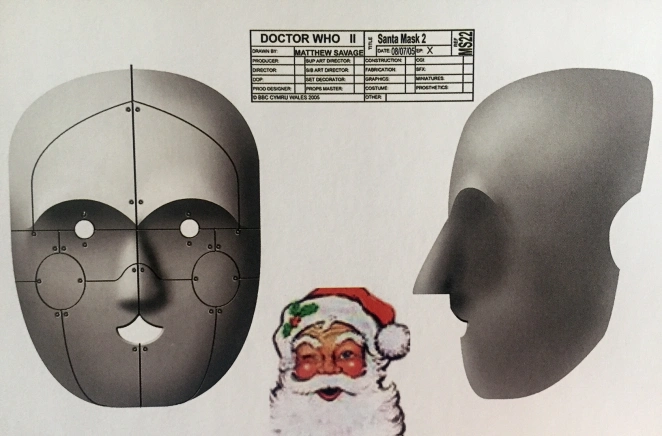
Concept art for the Santa Mask from The Christmas Invasion
WhoSFX: Was the pace quite relentless on Doctor Who?
Matthew: The office hours were quite long. Generally 7.30am until 7pm in the evening as a standard day. As a concept artist you are kind of shielded from the stress. At the end of the day all I had to produce was a drawing. Ed and the art departments actually had to physically bring them to life for the camera teams ready to move into. It is stressful and it can get heated but I enjoyed drawing so much that it was never really a massive stress for me.
WhoSFX: Were you guys feeling more confident moving into Series Two?
Matthew: Yeah, there’s always a bit of swagger coming back. Series One had clearly worked and there was a confidence when we came back. Everyone had worked together for a year and gone through trench warfare to get Series One done. So there’s a shorthand between departments and between construction teams. It’s still hard work but there’s an element of camaraderie when you come back.
WhoSFX: James Hawes says that New Earth nearly broke him. Was that a memorable one to work on?
Matthew: It was nice to bring Cassandra back. We were down on the Gower for the exterior stuff. I worked on The Intensive Care Unit, the bay of pods with the zombies in. It was red originally and it became green, like a Borg ship. The Doctor had to open one of the pods with his sonic. I included a nod to a scene in The Ark in Space when the Doctor used the sonic screwdriver to unscrew a bolt on the floor. When the Doctor opened the pod, I included a disc that resembled the screw in The Ark in Space that would turn with the sonic. That was a real fanboy indulgence! Mark Cordory built the door mechanism. Mark was a big fan too. He’s a really good friend actually. I haven’t seen him for years but I thoroughly enjoyed working with him on the various hand props used in the episodes. Like me he was involved from day one.
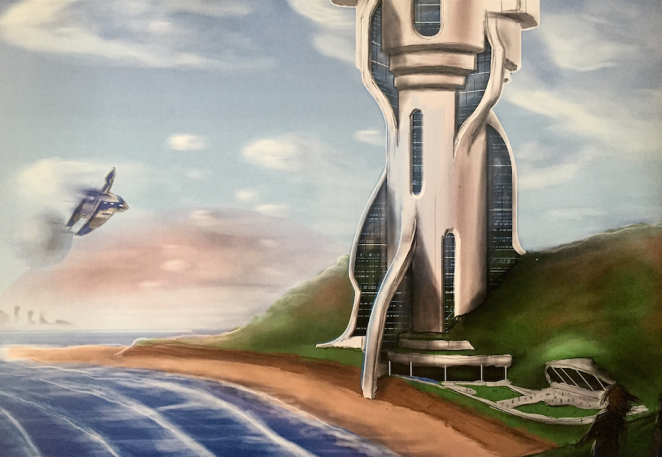
Matthew’s stunning concept art of the Hospital from New Earth
WhoSFX: Were you involved with Tooth and Claw?
This was the point that we were getting so busy that we got Pete (McKinstry) in and I think you’d have to credit Pete with most of the things in the werewolf episode. I think I designed a door that had mistletoe carved into it. I needed to take a holiday and Pete had e-mailed me a few times. You kind of get the measure of someone quite quickly as to whether or not they are a Doctor Who fan. And Pete very clearly was mad for it. I was very keen to get him involved so when I was off for a week or two we got him in. At that point, Ed knew that Torchwood was going to happen so he was beginning to double up on people. In a quiet way he was beginning t make the art department bigger and bigger for Torchwood and later The Sarah Jane Adventures. That was when it got busy and stressful! We were doing three shows instead of one. I’d forgotten all about that. It’s giving me a headache!
WhoSFX: Sarah Jane returned in School Reunion. What was your involvement there?
I did one very early pass at the Krilitanes. That was always going to go to The Mill. I didn’t have an awful lot to do with that episode. Conceptually there wasn’t a lot that needed designing. We were always more busy with the big sci-fi episodes. I remember going on set and obviously I had to see K9 when he was there. That was just the coolest thing. I loved the rust and the broken down treatment they gave him. That was another big moment. I remember seeing the trailer for Series Two at the end of The Christmas Invasion and you just knew that Doctor Who was fully back. That trailer was so joyous with the Cybermen and K9. It was a joyous time.
WhoSFX: You’ve done some amazing work over the years. Is it frustrating that Doctor Who is the thing that is brought up time and time again?
Matthew: The Doctor Who work is the stuff that I get the most kudos from after all these years. I love that connection. It was my first job and I look back at some of the work and it’s a bit naïve compared to what I do now. But I’ve always loved the show and I’ll always be proud to have any association with it.
Matthew, thank you very much.
We hope to speak to Matthew again about his massive contribution to Doctor Who and Torchwood. You can see more of his stunning work here:
https://www.instagram.com/doctorsavage/
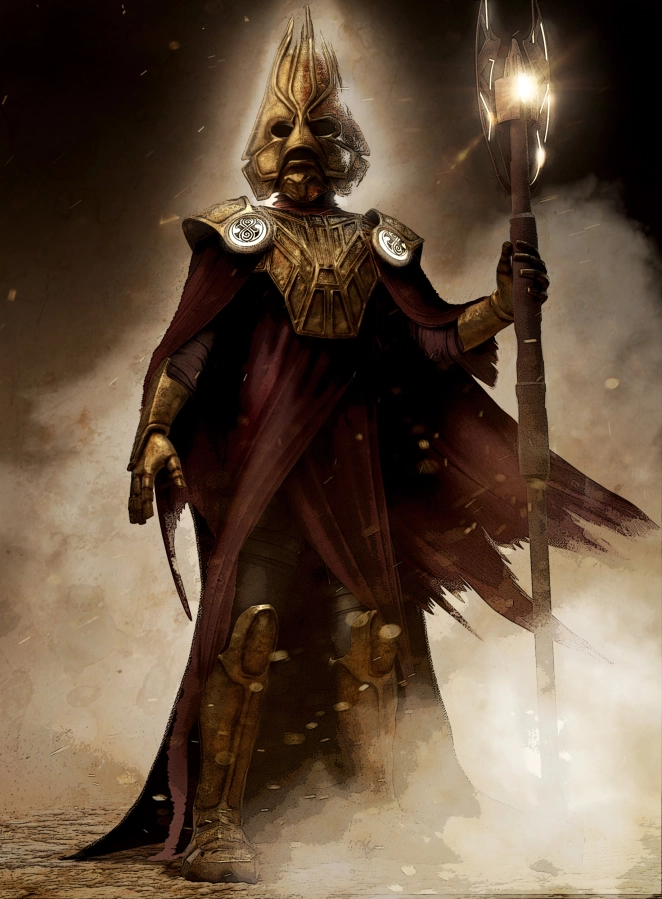
Glorious image of Omega by Matthew, ‘just for fun’.


